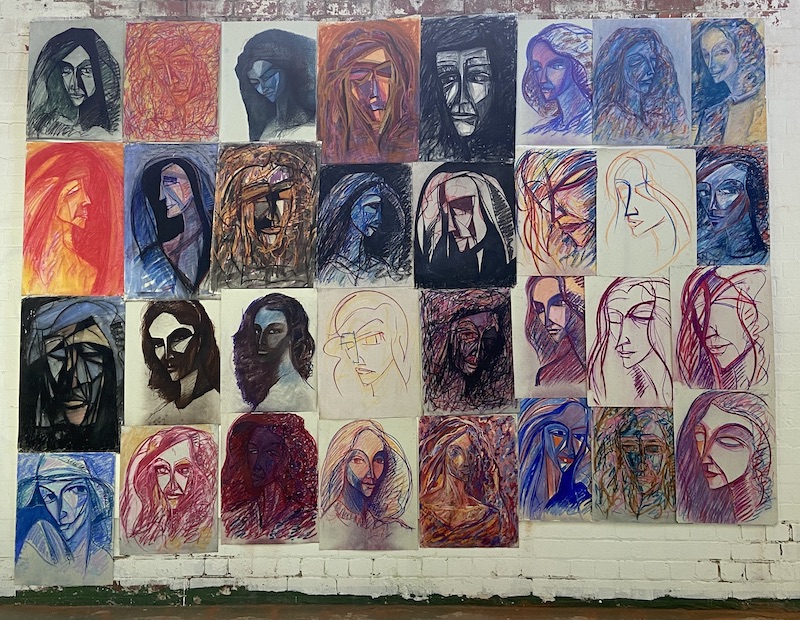Isabelle Leclezio is fascinated by the creative output of the late Ross Seaton, known as ‘the Walking Man’, a reclusive but prolific artist who worked to make sense of the world.
One man makes sense of the world
1 February 2021
- Reading time • 6 minutesVisual Art
More like this
- A walk with Tina Stefanou
- A blaze of glorious people
- Diving into the gothic world of Erin Coates
‘Ross Seaton: The Master of Nedlands’, Ross Seaton ·
The Naval Store, Fremantle, December 6, 2020 ·
The mysterious “Walking Man”, who pushed a wheelbarrow from Nedlands to the ocean every day for decades, was a familiar sight for many who saw him pass by. I have vivid memories of his mysterious hunched figure passing my primary school gate, while my friends and I conjured up wild imaginings of who he was and what he was doing.
As it turns out, his name was Ross Seaton, and he died last year, aged 76. He was a self-taught artist with a prolific interdisciplinary practice, his work often featuring materials he’d found on his walks.
Seaton was an uncommunicative and isolated individual for much of his life, quietly determined to pursue his artistic compulsion with complete and utter resolve. He created thousands of works over 50 years, a selection of which went on display last December in “Ross Seaton: The Master of Nedlands”, in the Naval Store in Fremantle (the works can still be viewed in an online exhibition, details below).
The captivating show was curated by Lawrence Wilson Art Gallery director Professor Ted Snell, whose monograph accompanying the exhibition, Ross Seaton: Walking Man, tells the story behind the enigma. The account of Seaton’s life and practice is as compelling as the artist’s work, and I can’t recommend it enough.

Entering the industrial expanse of the Naval Store, I was immediately impressed by the acrylic and oil paintings on builders’ plastic sheeting, hanging from floor to ceiling like big tapestries. Ambitious and striking, these giant works feature loud patterns of colours competing for space, emblazoned with messages in a secret alphabet.
Seaton was dedicated to perfecting his craftsmanship and produced many sophisticated abstract works. Particularly mesmerising for their visual depth are the untitled series of gouache works in shades of blue, created with layers upon layers of geometric shapes encased in a grid, reminiscent of the glimpses you might catch through the slats in a garden fence. I was also drawn to an oil work on ply, composed of beautiful pastel-blue and yellow blocks, shifting against one other and blurring at the edges in a pixelated mirage.
Repeated drawings of wildlife envelop an entire wall of the exhibition, many of them inscribed with ambiguous numbers. Preoccupied with numerology, Seaton meticulously recorded numerical details of his wheelbarrow walks, including passing bus routes, receipts, directions followed and time elapsed. He processed these numbers using perplexing arithmetic that no outsider can understand, diligently searching for an all-encompassing algorithm that could somehow help him make sense of the world.

Seaton’s other great fascination in life was his former wife, Marilyn – after they divorced, he continued to draw her for 40 years. He believed strongly that it was impossible to capture the complexities of a human psyche in a single portrait, so he created a multitude of representations in an array of colours that together illustrate all the facets of her personality. From the dark purple hues of evening to the bright orange and pink of sunrise, a bewitching Marilyn stares out at us, with her high cheekbones, strong jawline and encircling mane of hair.
I loved the exhibition’s inclusion of various objects from Seaton’s home: fence posts decorated in Tetris-like black marks, a huddle of cans erupting with congealed paint, multicoloured brushes poking out in every direction, and an assortment of bricks, each painted with a boab tree design. The items gave a small insight into the artist’s universe, where every treasure found on his walks was important and inextricably connected in his backyard cosmos of organised chaos.
Ross Seaton was an artist who belonged to all of us. He was an ever-present part of our lives, a pilgrim on a 30-year odyssey along Stirling Highway, turning the debris of the suburbs into extraordinary creations, pieces of the puzzle of our existence.
Feeling I had to visit Seaton’s world one last time, I returned to the exhibition on its final day to find that each painted brick now had a handwritten nametag: Patrick, Wendy, Ray, Trida, Baz … I smiled, knowing these little pieces of the Walking Man would soon make their way into the homes of Perth locals who had admired him as he passed by and will remember him forever. It was uplifting to see how the community of the western suburbs had embraced Seaton as an accomplished artist and a cherished part of Perth’s history.
“Ross Seaton: The Master of Nedlands” was on show in December last year at the Naval Store, Fremantle, as part of the Lawrence Wilson Art Gallery’s ‘UWA Away’ program. Click here to visit the online exhibition, which runs until December 4 this year.
Pictured top: Painted bricks, 2015-20, foreground, and some of the massive paintings on sheets of builders’ plastic that Ross Seaton embarked upon from 2014 onwards. Photo: Lyle Branson
Like what you're reading? Support Seesaw.






